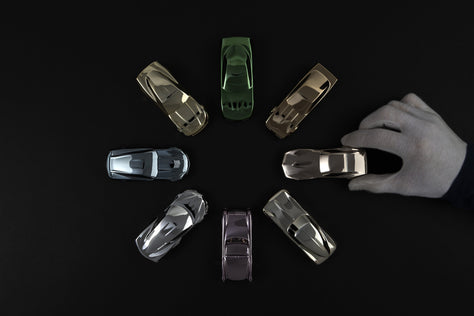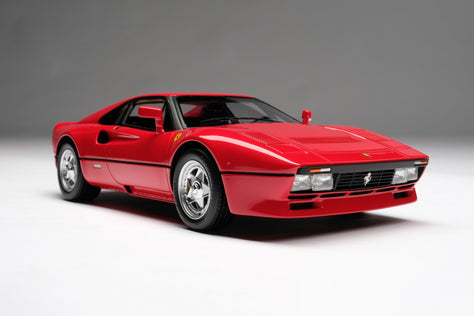技术详情
- 简介
- 比例指南
The F40 was to be a celebration of forty years of Ferrari. The company’s first supercar, although heavily influenced by the extreme machine philosophy of the 288 GTO, was never intended for a life on the racetrack. That is not to say, however, that it was lacking in purpose: its sophisticated high-performance, turbo-charged running gear combined with a first class chassis gave it the kind of great dynamic prowess that was close to that of a racing car. As the celebrated magazine Road & Track wrote, ‘The F40 may be one of the most single-minded road cars ever constructed’.
Mere months before his passing, a frail Enzo Ferrari announced from a podium at Ferrari headquarters in Maranello, Italy, a car that would change the world. That car, the F40, signalled the end of an era, both for the Ferrari brand and for performance cars in general. It was a demanding, Spartan supercar— “not particularly comfortable” even by the company’s own description. The F40 was designed expressly to be the fastest, sharpest, most aggressive Ferrari road car, ever. And it was about as close as you could get to a race car that had snuck out of the paddock and somehow gotten approved for road use.
In a way, the car had done just that. The F40’s roots are found in the 288 GTO Evoluzione, the rocket that Ferrari had been developing to do battle in the road-racing portion of the fabled Group B category of FIA-sanctioned racing. Rallying accidents killed the entire category before the Evoluzione could strut its stuff, leaving Ferrari with the decision about what to do with all the time, money, and remarkable engineering that had gone into the project. The answer came in the form of a German rival, caught in the same predicament.
Porsche had also been developing a Group B monster and was forced to turn that project into a road car. Known first as Gruppe B concept, that car eventually became the astonishingly fast and technologically advanced 959. Ferrari noticed the headlines and accolades the 959 drew and began to think his aborted Group B car could do the same. “This is a great car, we have to make it,” said Ferrari test driver Marco Toni of the Evoluzione. That was all that Enzo needed to hear. He tapped Nicola Materazzi, father of the 288 GTO and its Evoluzione counterpart, to build the road car. It would be the last road car that Enzo Ferrari personally approved.
The F40 debuted in 1987 and stunned evaluators with its blistering performance. A Road & Track test in October 1991 showed that the 478hp F40 could hit 60mph from a standstill in just 3.8 seconds and dispatch the quarter mile in 11.8 seconds, on its way to a top speed of 196 mph.
The Ferrari packed advanced engineering into its 2450mm wheelbase, including a twin-turbo V8 power unit and a lightweight Kevlar and carbon composite body. And yet, it was not a spaceship like the 959. If the Porsche was a glimpse into the technology-laden future, the F40 was heralded as the most distilled, most satisfying version of the old ways of doing things. It had none of the electronic nannies now standard in every modern performance car. It did not use trick engine mapping and traction control to augment lap times. No power steering, power brakes or ABS to reassure the driver. Weight was kept to a minimum: the composite body panels were built for strength and low weight; Lexan-clothed windscreen was used instead of glass; and the interior was sparse to say the least, with no sound system, glove compartment or elaborate trims or upholstery. The F40 demanded the utmost attention and focus. Give it that, though, and it would give back the best driving experience of any car on the road at the time and most of them since. For Enzo, who died in 1988, it was a fitting final act, and it pointed to a future in which his company would, even after his passing, be at the forefront of ultra-high-performance road cars. Only 1311 examples were produced.
This fine 1:18 scale model of the Ferrari F40 has been handcrafted and finished in our workshops with the co-operation and assistance of Ferrari regarding original finishes, materials, archive imagery and drawings. The use of supremely accurate digital scanning of the original car has allowed us to perfectly recreate every detail at scale. Furthermore, it has undergone detailed scrutiny by both the engineering and design teams at Ferrari to ensure complete accuracy of representation. Every Amalgam 1:18 scale model is supplied in a luxury black box with a protective outer carrying sleeve. Each model is mounted on a polished black acrylic base protected by a clear acrylic dust cover. The base holds a booklet containing the certificate of authenticity along with information and collateral material about the car. The model title and original branding is displayed on a polished stainless steel plaque mounted at the front end of the base.
Note: This is a 'Kerbside' model and does not feature any moving parts.
预订
定制款
In order for us to create your bespoke model, you will need to choose 4 extra options. Paint colour, interior colour, wheel style and caliper colour.
Please complete the form and a member of our Sales Team will contact you.
联系我们
请与我们联系以获取有关订购此型号的更多信息。


![[hide-in-gallery]](http://www.amalgamcollection.com/cdn/shop/files/DSCF9645WIDEEDIT_2000x850_crop_center.jpg?v=1698054649)




